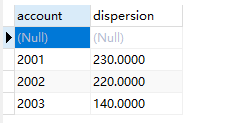在測試工作中,有時需要測試資料庫數據經過sql計算後的結果是否滿足某一功能查詢得到的返回值。 針對某些需要功能需要聯查多張表,此時 關聯 的作用就異常重要了,而針對多表關聯,其中 關聯條件的重要性不言而喻, 不同的關聯條件會得到不同的結果集。 廢話不多說,下麵開始做個實驗。 建表 data_stoc ...
在測試工作中,有時需要測試資料庫數據經過sql計算後的結果是否滿足某一功能查詢得到的返回值。
針對某些需要功能需要聯查多張表,此時 關聯 的作用就異常重要了,而針對多表關聯,其中 關聯條件的重要性不言而喻,
不同的關聯條件會得到不同的結果集。

廢話不多說,下麵開始做個實驗。
建表 data_stock1, data_stock2
drop table if exists data_stock1;
drop table if exists data_stock2;
-- 區分二表,通過amount取不同欄位
create table data_stock1(
account varchar(20),
amount1 int(10),
init_date varchar(10)
);
create table data_stock1(
account varchar(20),
amount2 int(10),
init_date varchar(10)
);
insert into data_stock1(account,amount1,init_date) values('2001',200,'20170101');
insert into data_stock1 (account,amount1,init_date) values('2001',30,'20170102');
insert into data_stock1 (account,amount1,init_date) values('2002',210,'20170102');
insert into data_stock1 (account,amount1,init_date) values('2003',70,'20170102');
insert into data_stock1(account,amount1,init_date) values('2002',10,'20170101');
表data_stock1,select * from data_stock1;
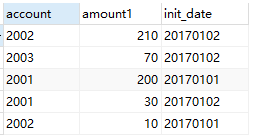
表data_stock2,自行插入值吧,數據如下,select * from data_stock2;

---------------------------------------------------我是分割線-------------------------------------
一切準備就緒;下麵實驗開始;將兩個表進行關聯,關聯 分為 外聯,內聯。
內聯 inner join ,內聯 的結果集 是data_stock2,data_stock1表中共同存在的結果;data in (data_stock2,data_stock1)
外聯 outer join ,分為全聯(full outer join),左聯(left join),右聯(right join),區別如下:
-- --左關聯, a.account=b.account
select *
from data_stock1 a left join data_stock2 b on (a.account=b.account);
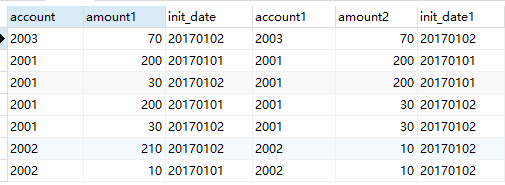
-- --左關聯,a.account=b.account and a.init_date=b.init_date
select *
from data_stock1 a left join data_stock2 b on (a.account=b.account and a.init_date=b.init_date);

-- --左關聯,a.account=b.account,再做聚合 求平均值
select a.account,(AVG(a.amount1)+AVG(b.amount2)) as dispersion
from data_stock1 a left join data_stock2 b on (a.account=b.account )
group by a.account;

-- --左關聯,a.account=b.account,再做聚合 求平均值
select a.account,(AVG(a.amount1)+AVG(b.amount2)) as dispersion
from data_stock1 a left join data_stock2 b on (a.account=b.account and a.init_date=b.init_date)
group by a.account;

-- --右關聯, a.account=b.account
select *
from data_stock1 a RIGHT JOIN data_stock2 b on (a.account=b.account);
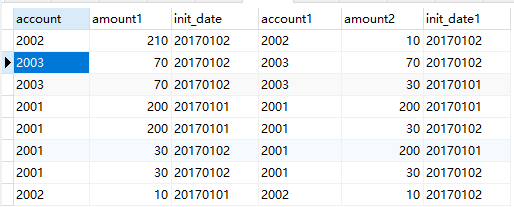
-- --右關聯,a.account=b.account and a.init_date=b.init_date
select *
from data_stock1 a RIGHT JOIN data_stock2 b on (a.account=b.account and a.init_date=b.init_date);

-- --內聯, a.account=b.account
--寫法1 ,select *
from data_stock1 a INNER JOIN data_stock2 b on a.account=b.account;
--寫法2, select *
from data_stock1 a , data_stock2 b where a.account=b.account;
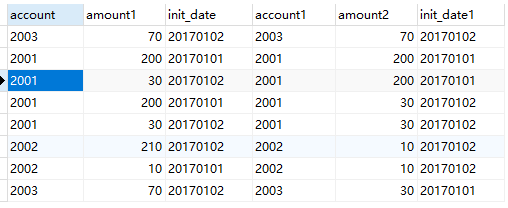
-- --內聯,a.account=b.account and a.init_date=b.init_date
select *
from data_stock1 a INNER JOIN data_stock2 b on (a.account=b.account and a.init_date=b.init_date);
select *
from data_stock1 a ,data_stock2 b where (a.account=b.account and a.init_date=b.init_date);

-- --右關聯,a.account=b.account,再做聚合 求平均值
select a.account,(AVG(a.amount1)+AVG(b.amount2)) as dispersion
from data_stock1 a RIGHT JOIN data_stock2 b on (a.account=b.account )
group by a.account;

-- --右關聯,a.account=b.account,再做聚合 求平均值,再做聚合 求平均值
select a.account,(AVG(a.amount1)+AVG(b.amount2)) as dispersion
from data_stock1 a RIGHT JOIN data_stock2 b on (a.account=b.account and a.init_date=b.init_date)
group by a.account;
註意,此時出現了 NULL賬號,是因為右聯的時候,結果集為NULL,而以 group by a.account做聚合,會有NULL
